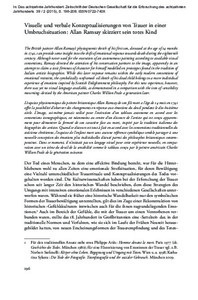| dc.date.accessioned | 2021-03-03T12:08:34Z | |
| dc.date.available | 2021-03-03T12:08:34Z | |
| dc.date.issued | 2015 | |
| dc.identifier | doi:10.17170/kobra-202102223343 | |
| dc.identifier.uri | http://hdl.handle.net/123456789/12573 | |
| dc.language.iso | ger | ger |
| dc.rights | Urheberrechtlich geschützt | |
| dc.rights.uri | https://rightsstatements.org/page/InC/1.0/ | |
| dc.subject.ddc | 700 | |
| dc.title | Visuelle und verbale Konzeptualisierungen von Trauer in einer Umbruchsituation: Allan Ramsay skizziert sein totes Kind | ger |
| dc.type | Aufsatz | |
| dcterms.abstract | The British painter Allan Ramsay’s physiognomic sketch of his first son, deceased at the age of 14 months in 1741, can provide some insight into the shift of emotional response towards death during the eighteenth century. Although never used for the execution of an autonomous painting according to available visual conventions, Ramsay directed the attention of his conversation partners to the image, apparently in an attempt to claim a stoic firmness of character for himself modelled on prototypes found in the tradition of Italian artistic biographies. While this later response remains within the early modern conventions of emotional restraint, the symbolically ›unframed‹ oil sketch of his dead child belongs to a more individual experience of emotions inspired by Scottish Enlightenment philosophy. For this new experience, however, there was yet no visual language available, as demonstrated in a comparison with the icon of ›sensibility mourning‹ devised by the American painter Charles Willson Peale a generation later. | eng |
| dcterms.abstract | L’esquisse physionomique du peintre britannique Allan Ramsay de son fils mort a l’âge de 14 mois en 1741 offre la possibilité d’observer des changements en réponse aux émotions du deuil pendant le dix-huitième siècle. L’image, soi-même jamais utilisé pour l’exécution d’un tableau autonome en accord avec les conventions iconographiques, est néanmoins au centre d’un discours de l’artiste qui est conçu apparemment pour démontrer la fermeté de son caractère face au mort, inspiré par la tradition italienne des biographies des artistes. Quand ce discours est tout à fait en accord avec les conventions traditionnelles du stoïcisme chrétienne, l’esquisse de l’enfant mort sans aucune référence symbolique semble partager à une nouvelle conception des émotions plus individuelles discuté parmi des philosophes britanniques contemporaines. Dans ce moment, il n’existait pas un langage visuel pour cette expérience nouvelle, en comparaison avec un icône du deuil de la sensibilité comme le tableau conçu par le peintre américain Charles Willson Peale de la génération suivante. | fre |
| dcterms.accessRights | open access | |
| dcterms.creator | Joachimides, Alexis | |
| dc.subject.swd | Ramsay, Allan | ger |
| dc.subject.swd | Trauer <Motiv> | ger |
| dc.subject.swd | Kunst | ger |
| dc.type.version | publishedVersion | |
| dcterms.source.identifier | ISSN 0722-740X | |
| dcterms.source.issue | 2 | |
| dcterms.source.journal | Das achtzehnte Jahrhundert. Zeitschrift der Deutschen Gesellschaft für die Erforschung des achtzehnten Jahrhunderts | ger |
| dcterms.source.pageinfo | 196-208 | |
| dcterms.source.volume | 39 | |
| kup.iskup | false | |

